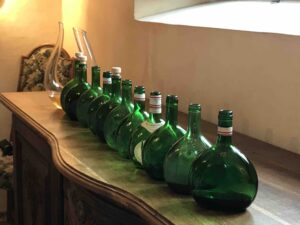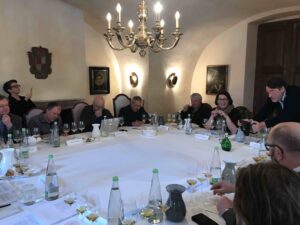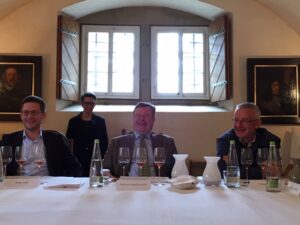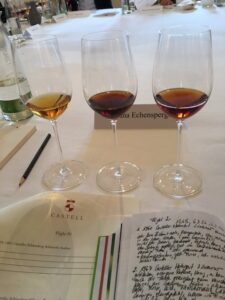Silvaner from 7 decades
A special wine tasting held at Schloss Castell castle
Even I rarely have the opportunity to taste really mature wines. For that reason, I simply could not miss the tasting of rare wines held at Schloss Castell castle on January 26, 2019. Of course, a further argument was that the subject was one of my favorite grape varieties– Silvaner. I was duly keen to see which wines Ferdinand Fürst zu Castell-Castell would present to us. The invitation had gone out to an illustrious round of wine specialists. We were guided through the tasting by the estate manager Peter Geil and by cellar master Christian Frieß, who supplied us with fascinating information.
(pictures: Barbara Wanner)
Here are my impressions:
1st Flight:
The session kicked off with 3 dry Silvaners. In this case it was not only relevant to note the quality and the vintage differences, but also to see how differently wine was made at the time. The wines were automatically left on the skins for some time. After all, the grapes were destemmed during picking and kept in an open container, and were left to stand there until there was time to press the grapes. Naturally, the must was fermented in large oak vats using natural wild yeasts, and, as the producer was a member of the „Verband Deutscher Naturweinversteigerer“ (today VDP), no chaptalization took place. As a result, the 1957 vintage was a genuine lightweight at only 7.5% alcohol. The Silvaner from the exceptionally good 1959 vintage was in a class of its own.
1957 Casteller Schlossberg Silvaner trocken (dry)
(Analysis: Alc.: 7.54 % vol., Res. sugar: 0.0 g/l, Total Acidity: 8.3 g/l)
„A catastrophic vintage,“ that is how the cellar master described the 1957 vintage. The chemical analysis, too, already gives an inkling that this was a really cool vintage. The wine was bottled at an alcohol level of only 7.5%, and a level of acidity that is markedly high for a Silvaner. As the estate was a member of was a member of the „Verband Deutscher Naturweinversteigerer“ (dedicated to natural production methods), naturally no chaptalization took place. In the glass, the wine presented itself in a brilliant pale gold color. The nose revealed a complex bouquet, with aromas of honey, caramel, orange zests and toasted nuts, characteristics that one would normally expect from a more voluminous wine. Dry on the palate, very light-bodied, with a very crisp and still vibrant acidity. A very respectable wine, albeit not a great one.
1959 Casteller Silvaner
(Analysis: Alc.: 12.14% vol., Res. sugar: 1.0 g/l, Total Acidity: 6.0 g/l)
Here one could immediately appreciate the quality and ripeness of the 1959 „vintage of the century“. It was fascinating to follow the development in the glass. The first impression was rather restrained, even slightly musty. Once the glass had been agitated for some time, a complex bouquet opened up, with nutty aromas, as well as the prominent powerful, deep vegetal aromas typical of keuper soils. Very powerful on the palate, with fine tannins, in spite of the low level of alcohol at only 12%. Incredibly precise, and elegantly matured. A fantastic dry Silvaner and a great wine.
1959 Casteller Schlossberg Scheurebe
(Analysis: Alc.: 12.2 % vol., Res. sugar: 0.0 g/l, Total Acidity: 7.4 g/l)
I am always curious to come across a Scheurebe from keuper soils. These soils encourage the grape variety to develop particularly intense aromas. „That must have been the maiden vintage,“ surmised cellar master Christian Frieß. The amber color indicated a clearly more advanced level of maturity than in the other wines. Volatile acidity was clearly noticeable on the nose. The color as well as the honeyed aromas strongly indicated the influence of botrytis. Slowly and gradually, further aromas of grapefruit zests and petrol came to the fore. On the palate, the wine appeared slightly brittle, and fell apart quite quickly. My verdict on this wine was “respectable, but not great”.
Had obviously a lot of fun, too: the three masterminds behind Schloss Castell: CEO Peter Geil, Fürst Ferdinand zu Castell-Castell and cellar master Christian Frieß. (picture: Romana Echensperger)
2nd & 3rd Flight
These flights showed wines that had not been fermented completely dry. I must admit that I find a few grams of residual sugar in mature white wines to be very attractive. The wines simply show an inimitable hedonistic creaminess.
What was particularly evident here were the vintage differences, which today would not be seen to such a marked extent. Given improved canopy and yield management, selection and cellar technology, one is today in a position practically to make up for all vintage differences.
1960 Casteller Hohnart Silvaner
(Analysis: Alc.: 12.6 % vol., Res. sugar: 6.3 g/l, Total Acidity: 6.2 g/l)
The cellar master described 1960 as the „overflow vintage“. “There was so much wine, that the tank storage space was insufficient, and in some places swimming pools were filled with wine.“. Indeed, the average yield of this vintage was an impressive 65 hl/ha, and that of a very good quality. The wine showed an amber color. The first impression on the nose was rather restrained. Gradually, a complex bouquet unfolded, with aromas of honey, caramel, biscuits, orange zests and pipe tobacco. Very prominent smoky notes were noted. On the palate, the wine had a creamy texture, a few grams of residual sugar made the wine approachable, with smoky and fresh minty notes on the back palate. An overall cool finish completed the complex impression. A very good wine.
1967 Casteller Hohnart Silvaner
(Analysis: Alc.: 12.98% vol., Res. Sugar: 7.3 g/l, Total Acidity: 4.4g/l)
This wine comes from a vintage that was considered to be a botrytis vintage. In the glass, the wine shows a gold color with typical orange reflexes on the rim. The bouquet is fascinating, with, on the one hand, sweet notes of nougat and honey, but also with the typical vegetal aromas typical of Silvaner grown on keuper soils, sweet and tart sprigs of spruce and wild orchard flowers. On the palate, the wine is mouth-filling, with a creamy texture reminiscent of nougat, livened up by a moderate but piquant acidity. There is a sophisticated kick of peppery spice and mint on the finish. The wine shows fantastic length and concentration, and the 13% alcohol comes across as a pleasantly warm sensation. A great wine.
1963 Casteller Schlossberg Rieslaner
(Analysis: Alc.: 11.6 % vol., Res. Sugar: 13.8 g/l, Total Acidity: 9.3 g/l)
Rieslaner is a recent new cross-breed of Riesling and Silvaner, created in 1921 at the viticultural college in Veitshöchheim. One of the many anecdotes presented on this afternoon was the story that the new grape variety was given its name at the Schloss Castell castle. The 1963 vintage was left to ferment spontaneously in large barrels, and this fermentation eventually stuck at a residual sugar level of 14 g/l. The wine was a little hazy, and showed an amber color. In the glass, the nose was very intense with aromas of dried exotic fruit, as well as signs of maturity reminiscent of Riesling, such as ashes, Earl Grey, cotton candy and a hint of notes of a delicious lemon curd tart. The acidity was brilliant, clear and vibrant, cutting through the wine like a sharp knife. Citrus notes and minty traces showed up again on the finish. A fantastic wine.
1970 Silvaner Hohnart Spätlese
(Analysis: Alc.: 9.7 % vol., Res, Sugar: 8.0 g/l, Total Acidity: 5.8 g/l)
From another cool vintage. The harvest took place as late as November, and the wine was bottled at just on 10% alcohol and 8 g/l of residual sugar. This wine was one of the weak points of the tasting. Volatile acidity dominated the bouquet. The acidity appeared green. Overall, the wine appeared to be rather thin, faded and blurred.
1971 Trautberg Silvaner Spätlese
(Analysis: Alc.: 11.7 % vol., Res. Sugar: 12.5 g/l, Total Acidity: 5.8 g/l)
In the glass, this wine initially showed a complex bouquet with aromas of orange zests, Vanilla, mocha, pipe tobacco, mint, yellow fruit and verbena. On the palate, the wine was surprisingly smoky, the acidity was juicy, which on the finish turned into a piquant note reminiscent of chili. A hint of honey on the nose as well as a phenolic impression on the palate revealed some botrytis, which fitted into the wine seamlessly. The wine was creamy, and that, together with an extremely long finish made this wine one of the highlights of the tasting.
1971 Müller-Thurgau Spätlese
(Analysis: Alc.: 11.9 % vol., Res. Sugar: 15.8 g/l, Total Acidity: 3.9 g/l)
Dark amber color. On the nose, aromas of chocolate pudding, cream, mocha. On the palate elegant sweet notes (15.8 g/l residual sugar), moderate acidity (3.9 g/l), and an overall light style. Respectable for a Müller-Thurgau – but not a great wine.
From left to the right the vintages: 1963 / 1976 / 1967 – different sulfur levels means different colors…. (picture: Romana Echensperger)
4th & 5th Flight
This was a trip across all the predicate levels. It was fascinating to describe the differences in color. While the wines dating back to the 1960’s were fairly light, the wine from the 1976 vintage was almost black. In other words, the sugar had almost completely oxidized. „The sulfur levels were laid down in the 1971 wine law,“ explained Christian Frieß. „Until that point in time, one had simply added as much sulfur as one felt one needed.“
Also, I realized once again how little one knows about the specific characteristics of the high predicate levels. Botrytis not only concentrates sugar and acidity, it also destroys the primary fruit aromas, and, particularly, ensures the production of glycerin. This provides a full-bodied, viscous mouth-feel. When an ice wine, such as that of the 1983 vintage, is picked entirely without any botrytis, it lacks this creamy characteristic. It is a very special and increasingly rare experience to be able to drink such wines. One also realized once again how different botrytis can appear, depending on the vintage.
1963 Schlossberg Scheurebe Auslese
A wine that clearly showed botrytis characteristics. Aromas of nougat, honey, mandarin peel and a hint of grapefruit zests. The sweetness was completely interwoven into the wine, and its texture was reminiscent of silky tannins. A very good wine, but not a great one.
1976 Schlossberg Silvaner Beerenauslese
This wine already started off with an incredible color. As the wine was poured into the glass, it was as black as a P.X. sherry. On the nose, it presented a fireworks of intense aromas of malt, hay, spruce honey, nougat and coffee. Perfectly concentrated on the palate, sweet with caramelized notes, a hint of candied herbs, toast, tobacco and moderate bitter traces reminiscent of an espresso. A fantastic wine.
1967 Schlossberg Silvaner Beerenauslese
(Analysis: Alc.: 8.3 % vol., Res. Sugar: 246.4 g/l, Acidity: 10.8 g/l)
A wine with a curious history. „This wine was simply forgotten“ explained Christian Frieß in his inimitable dry style. „At some stage we rediscovered the half-full barrel of Beerenauslese. How long it had stood there – no idea. It certainly did not harm the wine.“ A sentiment one can only agree with. In the glass, the wine showed a deep amber hue. On the nose, intense aromas of orange zests, concentrated and candied exotic fruit and some honey. Not as ripe as the 1976 vintage wine, but still tremendously vibrant. Very creamy on the palate, concentrated, and balanced by an almost cutting, vibrant acidity. Incredible length on the finish, and a fantastically pleasurable experience.
1983 Schlossberg Silvaner Eiswein – picked on November 15
„A good vintage with a large production volume. There was even enough ice wine to fill a Doppelstück (barrel size holding 2400 liters, more than 600 gallons),“ recounts Christian Frieß. That meant an incredible amount of 2400 liters of ice wine! 1983 is without a doubt THE year for ice wine. The frost arrived early, and affected healthy grapes, thus concentrating the pure fruit characteristics. Not even a hint of botrytis to muddy the impression. A complex nose with aromas of dried rose petals, hay flowers, mandarin peel, grapefruit – overall very fresh, vibrant notes. A veritable explosion on the palate. Vibrant acidity and a texture reminiscent of white chocolate. In spite of the sweetness, the wine remains light-bodied, indeed weightless in an inimitable fashion. Fantastic!
1983 Kugelspiel Rieslaner Trockenbeerenauslese (TBA)
Whereas the ice wine was particularly successful, the Trockenbeerenauslese from the same vintage failed to convince. Here one could clearly sense a „wet“ botrytis, in other words, there was more grey rot in play than true noble rot. Medicinal notes on the nose, nail varnish remover, volatile acidity. The wine appeared buttery on the palate, the sweetness put on rather than integrated. Not a great wine.
1971 Hohnart Silvaner Trockenbeerenauslese (TBA)
This wine really brought home to me how different the vintages for botrytis wines can be. Whereas the 1983 TBA was not a great success, the 1967 Beerenauslese showed crystal-clear botrytis. The heat in 1971 had resulted in the grapes drying out, with basically very little botrytis present. As a result, the wine showed a totally different range of aromas and textures. It showed a dark mocha color when poured into the glass. On the nose, there were aromas of dates and raisin, sweet spices such as cardamom, but also notes of ashes, coffee, toffee, and roasted hazelnuts. Quite voluminous on the palate, an oily texture that was characterized more by sweetness than by acidity. A mouth-filling, powerful sweet wine with tremendous punch and a long finish. A great wine.
Conclusion: The tasting has once again shown that Silvaner must be counted among the noble grape varieties. The aging potential is equal to that of a Riesling and also the Silvaner could convince in all „Prädikate“. Once again, I realized what a great terroir is in Franconia. The character of the Keuperboden was unmistakable in all wines. A soil with high calcium sulphite content. This apparently promotes the production of aromatic sulfur compounds such as thiols. Bittersweet flavors that are responsible for notes of grapefruit, meadow herbs, moss and lime peel. The rich texture and mineral spiciness of these wines can be assigned to the special terroir, too. Silvaner is the perfect ambassador for this.
Romana Echensperger MW
Translation by Peter Gebler



